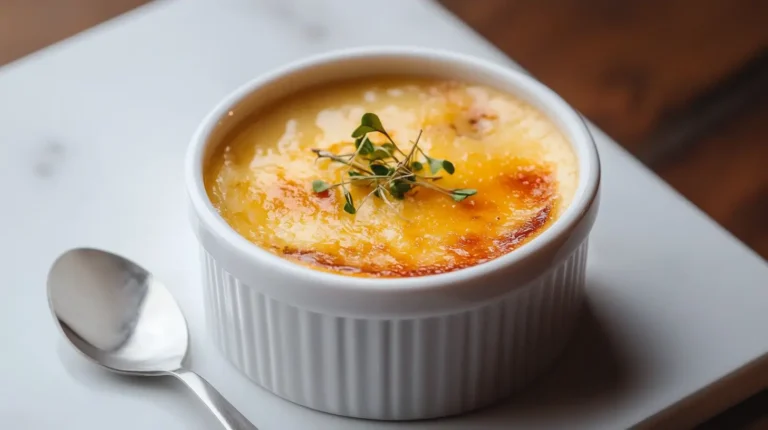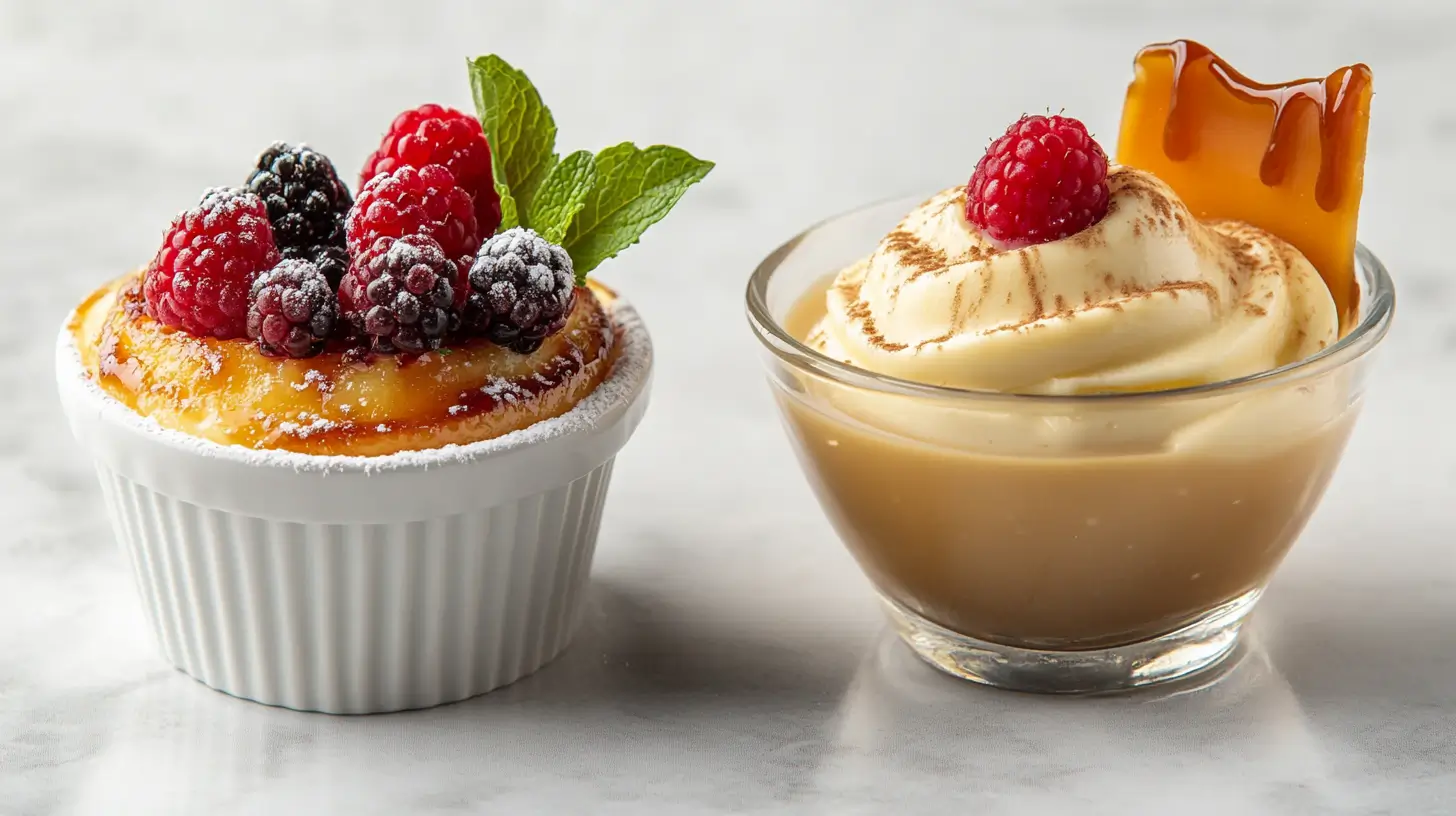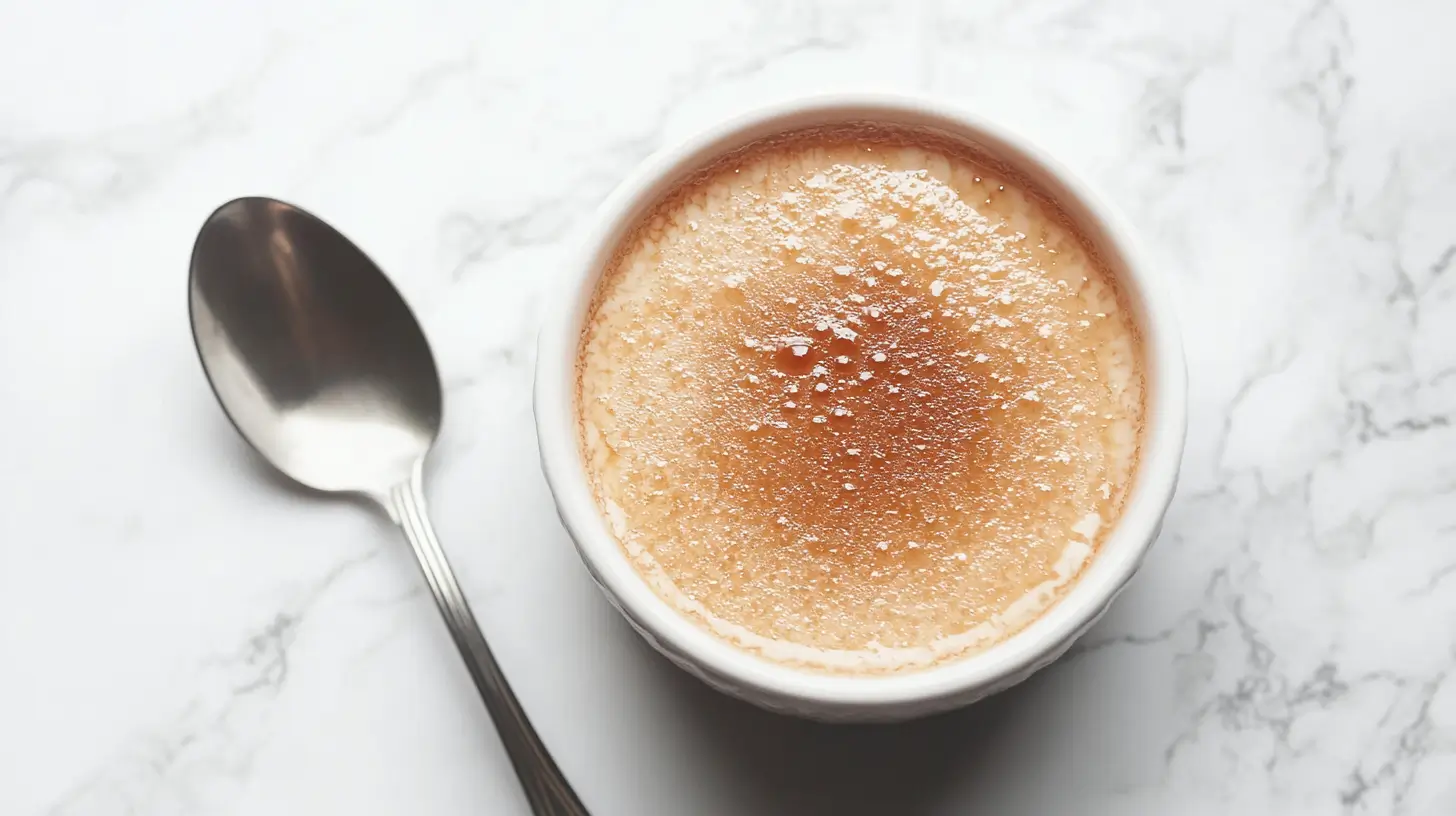Crab brulee recipe is a gourmet delicacy that marries the rich, savory flavors of crab with the silky texture of a custard. This unique dish delivers a surprising contrast of creamy seafood and a crackly caramelized crust. Whether you’re hosting a dinner party or indulging in an elevated culinary experience, learning the crab brulee recipe is a must. This article will provide you with a comprehensive guide, from understanding the dish’s origins to perfecting the final torching technique.
What is Crab Brulee?
The Crab Brulee Recipe is a savory twist on the classic French dessert crème brûlée, creatively reimagined with seafood flair. Instead of sweetness, this dish combines rich, creamy custard with delicate fresh crab meat, enhanced by herbs, spices, and sometimes cheese.
The signature brûléed top—usually a torched sugar or Parmesan crust—adds a satisfying crunch that contrasts beautifully with the smooth custard beneath. Elegant and unexpected, this crab brulee recipe works wonderfully as a luxurious appetizer or a stunning main course centerpiece.
Origins of Crab Brulee Recipe
While the crab brulee recipe feels modern, it is inspired by classic culinary traditions. Its foundation lies in French cuisine, renowned for its mastery of custards and torched desserts. The fusion of seafood with custard likely emerged from chefs seeking to combine unexpected flavors. Over time, crab brulee gained popularity in coastal regions where fresh seafood is abundant. Today, it is celebrated globally for its distinctive taste and texture.
Ingredients for the Perfect Crab Brulee Recipe
Selecting Fresh Crab
Fresh crab meat is the cornerstone of any great crab brulee recipe. Opt for live crabs if possible, as they guarantee the sweetest, most flavorful meat. If fresh crab is unavailable, high-quality canned or frozen crab can serve as a substitute. Look for meat labeled as lump or jumbo lump for the best results. Avoid overly processed crab products, as they often lack the rich taste necessary for this dish.
Tips for Selecting the Best Crab:
- Appearance: Choose crab meat that is white and flaky, free of grayish hues or watery residue.
- Smell: Fresh crab should have a light, oceanic scent, not a strong fishy odor.
- Storage: If using fresh crab, keep it chilled and cook within 24 hours for optimal flavor.
Key Ingredients: Balancing Creaminess and Flavor
To create the velvety custard base, you’ll need a few essential ingredients that perfectly complement the crab. The blend of cream, eggs, and cheese adds richness without overpowering the delicate seafood. Herbs like tarragon or chives enhance the aroma, while a dash of cayenne pepper adds a subtle kick.
Must-Have Ingredients:
- Heavy cream for a silky texture
- Egg yolks to create a stable custard
- Fresh crab meat for a sweet, briny taste
- Grated Gruyère or Parmesan cheese for depth of flavor
- Herbs and spices for added complexity
Substitutes for Unique Diets
Adapting the crab brulee recipe to dietary preferences is simple with a few ingredient swaps. For dairy-free versions, coconut cream can replace heavy cream, and nutritional yeast can substitute cheese. If you’re avoiding eggs, a cornstarch-thickened custard can mimic the texture. Vegetarian versions can substitute crab with jackfruit or hearts of palm for a similar texture.
Step-by-Step Instructions for a Perfect Crab Brulee Recipe
Preparing the Crab Mixture
To begin your crab brulee recipe, carefully shred fresh crab meat into small pieces, ensuring there are no shell fragments. Toss the crab with a splash of lemon juice, a pinch of salt, and finely chopped herbs. This simple step infuses the crab with flavor and enhances the depth of the final dish.
Creating the Silky Custard Base
The custard is the luxurious foundation of your crab brulee recipe. In a mixing bowl, whisk together heavy cream, egg yolks, and grated cheese until smooth. Be gentle to avoid incorporating too much air, which can create unwanted bubbles during baking. Season with cayenne pepper, salt, and freshly ground black pepper to bring warmth and balance.
Assembling and Baking the Crab Brulee
To assemble, spoon the crab mixture evenly into ramekins. Pour the custard over the crab, filling the ramekins just below the rim. Place the ramekins in a baking dish filled with water to create a water bath, which ensures even cooking. Bake at 325°F (160°C) until the custards are set but still slightly wobbly in the center, usually about 30 minutes.
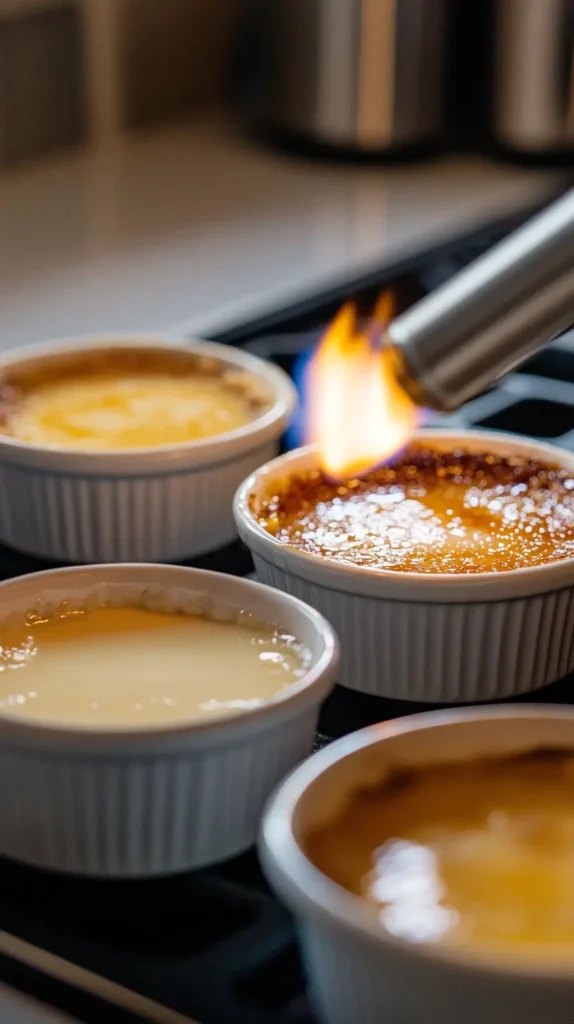
Tips for Achieving a Perfectly Torched Crust
One of the most distinctive features of a crab brulee recipe is the crisp, caramelized topping. Mastering the torching technique is key to achieving restaurant-quality results.
Essentials for a Flawless Finish
- Use Fine Sugar: Sprinkle a thin, even layer of sugar on the custard’s surface for the best caramelization.
- Invest in a Kitchen Torch: A kitchen torch provides precise control, allowing you to achieve a golden-brown crust without overcooking.
- Cool Before Torching: Let the custards cool completely before torching to avoid melting the custard.
Step-by-Step Torch Technique:
- Hold the torch a few inches above the sugar layer.
- Move in circular motions to evenly distribute heat.
- Stop once the sugar melts and forms a crisp, amber-colored crust.
By following these steps, your crab brulee recipe will boast a professional finish, impressing even the most discerning guests.
Common Mistakes to Avoid
Crafting a flawless crab brulee recipe can be daunting without proper guidance. Many common errors can affect the dish’s flavor or texture. Overcooking is one of the most frequent mistakes; it can result in a rubbery custard instead of the smooth, creamy base desired. Another pitfall is using subpar crab meat—low-quality or imitation crab lacks the sweetness and flavor needed for this dish.
Avoid adding too much sugar for the topping, as an overly thick crust can overpower the delicate custard. Additionally, improper mixing of the custard can lead to uneven textures, so always whisk thoroughly but gently. To prevent these issues, follow each step carefully and ensure all ingredients are fresh and high-quality. Mastering these details will help you create a crab brulee recipe that exceeds expectations.
Nutritional Value of Crab Brulee Recipe
Health Benefits of Crab
Crab meat, a key ingredient in the crab brulee recipe, is not just flavorful but also packed with nutrients. It’s an excellent source of lean protein, making it ideal for muscle repair and overall health. Crab contains essential vitamins like B12, crucial for brain function and energy production. Additionally, it’s rich in minerals like zinc, selenium, and omega-3 fatty acids, which support immunity and heart health.
Eating crab regularly can contribute to a balanced diet without adding excessive fat or calories. Its naturally sweet and light flavor makes it a guilt-free indulgence when prepared in dishes like crab brulee.
Caloric Breakdown of Crab Brulee
The crab brulee recipe offers a balanced caloric profile when portioned appropriately. A single serving typically contains about 300–400 calories, depending on the cream and cheese used. While this dish is higher in fats due to the cream, these are mostly healthy fats that provide long-lasting energy.
To reduce calories, substitute heavy cream with a lighter alternative or use less cheese without sacrificing flavor. This balance makes crab brulee a versatile option for both indulgent meals and mindful eating plans.
Serving Suggestions
Pairing Crab Brulee with Flavorful Sides and Beverages
A well-rounded dining experience with crab brulee recipe requires thoughtful pairings. For sides, consider light and refreshing options like a mixed green salad with citrus vinaigrette or roasted asparagus. These complement the rich custard without overwhelming the palate.
For beverages, opt for non-alcoholic choices that balance the dish’s creaminess. Sparkling water with a hint of lemon or lime offers a crisp, refreshing contrast. Alternatively, herbal teas like chamomile or mint provide a soothing and aromatic accompaniment. A chilled glass of cucumber-infused water can also enhance the dining experience, adding a touch of freshness to every bite.
Accompaniments to Elevate the Experience
To enhance your crab brulee recipe, include accompaniments that amplify its flavors. A drizzle of truffle oil on the custard before serving adds an earthy sophistication. You could also garnish with microgreens or a sprinkle of fresh chives for added color and aroma.
Breadsticks or crostini make excellent additions, offering a crunchy element to balance the creaminess of the dish. These small touches transform your crab brulee into a memorable dining centerpiece.
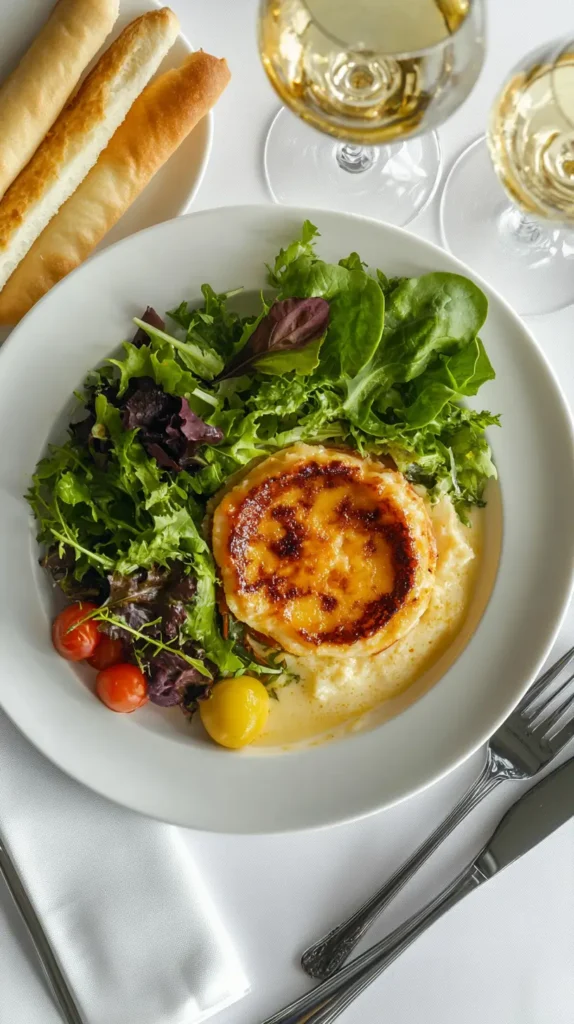
Variations of Crab Brulee
Spicy Crab Brulee
For those who enjoy a bit of heat, a spicy version of the crab brulee recipe is a must-try. Add finely diced jalapeños or a pinch of cayenne pepper to the custard mixture for a subtle kick. Top with chili flakes before torching the sugar crust to create a bold, flavorful twist that excites the taste buds.
Vegetarian Alternatives
Vegetarians can still enjoy the textures and flavors of crab brulee recipe with creative substitutions. Replace crab with artichoke hearts, jackfruit, or hearts of palm for a seafood-like texture. Season these alternatives with seaweed or Old Bay seasoning to mimic the briny taste of crab.
Use the same custard base, ensuring the cream and cheese remain the star ingredients. These swaps allow vegetarians to indulge in this gourmet delight without compromising on flavor.
Frequently Asked Questions (FAQs)
What is the secret of crème brûlée?
The secret to a perfect crème brûlée lies in achieving the ideal balance between a creamy custard base and a crisp, caramelized sugar crust. To do this, it’s crucial to use fresh, high-quality ingredients, such as heavy cream, fresh egg yolks, and vanilla. Properly tempering the egg yolks with warm cream ensures the custard is silky smooth, avoiding curdling. Baking the custards in a water bath at a low, even temperature prevents overcooking. Finally, torching the sugar topping evenly creates the signature crackly crust that contrasts beautifully with the velvety custard.
What’s the difference between crème brûlée and custard?
While both crème brûlée and custard share a creamy texture and egg-based foundation, the key difference lies in the preparation and presentation. Crème brûlée is a specific type of custard topped with a caramelized sugar crust, achieved by sprinkling sugar and torching it until it melts and hardens. Regular custard, on the other hand, is often served plain or as a filling for desserts like pies and pastries. The texture of crème brûlée is slightly firmer due to its baked preparation, while custard can range from pourable to thick and pudding-like.
Can you use milk instead of heavy cream in crème brûlée?
Yes, you can use milk instead of heavy cream in crème brûlée, but it may affect the texture and richness of the dessert. Heavy cream provides the signature creaminess and luxurious mouthfeel of traditional crème brûlée. If substituting, whole milk is the best option, as it has the highest fat content among milk varieties. To retain some of the richness, consider combining milk with a small amount of butter or using half-and-half. Keep in mind that using milk alone may result in a lighter, less indulgent custard.
Can I make crème brûlée without ramekins?
Yes, you can make crème brûlée without ramekins by using alternative heatproof dishes. Small glass jars, ceramic bowls, or shallow baking dishes work well as substitutes. The key is to ensure the dishes are oven-safe and of similar depth to ramekins for even cooking. Keep in mind that larger or deeper dishes may require longer baking times. Regardless of the container, always use a water bath to maintain gentle, even heat during baking and achieve the creamy texture crème brûlée is known for.
Conclusion: Why You Should Try Crab Brulee Today
The crab brulee recipe is a culinary masterpiece that offers a harmonious blend of creamy textures, savory flavors, and a satisfying crunch. Whether you’re a seasoned chef or a curious food enthusiast, this dish is worth exploring for its uniqueness and versatility. From its nutritional benefits to its endless pairing possibilities, crab brulee is a true celebration of fine dining. Treat yourself and your guests to an unforgettable experience by adding this sophisticated dish to your repertoire.
Looking for daily recipe inspiration? Follow us on Pinterest and Facebook to explore delicious, home-style recipes shared every day!

